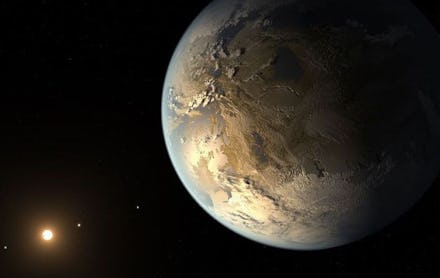New Study Reveals Best Evidence Yet That Alien Life Could Exist on Other Planets

The news: The Milky Way could have as many as 100 million planets with complex life, according to a new study published in Challenges from researchers at the University of Texas at El Paso. Lead researcher Louis Irwin and his team studied data from more than 1,000 exoplanets and derived this enourmous figure from their results.
That's a lot of planets that could support life, and the projection is one of the most favorable so far to the hypothesis that life exists on other worlds in the vastness of the cosmos. That said, there are a lot of caveats.
The science: Irwin and the team ranked the exoplanets according to a "biological complexity index" (BCI), including factors like distance from their star, projected temperature, density, substrate (liquid, solid or gas), chemistry and age. They assumed an average of one planet per star across the known universe, and that Jupiter's moon Europa would be a good model candidate for life. With 10 billion stars in the universe, that narrows it down to 100 million planets with the potential to support multicellular life.
"The BCI calculation revealed that 1% to 2% of exoplanets showed a BCI rating higher than Europa, a moon of Jupiter thought to have a subsurface global ocean which could harbor different forms of life," writes researcher Dirk Schulze-Makuch. "Based on an estimate of 10 billion stars in the Milky Way Galaxy, and assuming an average of one planet per star, this yields the figure of 100 million. Some scientists believe the number could be 10 times higher."
There's some important context here: The researchers are only suggesting that the right conditions to support life more complicated than a microbe could exist on 100 million planets, which is a fairly middling projection. And most known planets with high enough BCI ratings to be a life candidate are far away, like one in the Gliese 581 system, which is around 20 light-years away. They're also larger, warmer and older, suggesting their life might not resemble ours.
If the 100 million planets projected by the study were evenly spaced throughout our galaxy alone, they'd be an average of 24 light years apart. Projecting life is one thing; actually finding it is quite another.
The background: As space science moves forward, it's getting better and better at finding exoplanets. Since the Kepler Space Telescope launched in 2009, it's found 1,800 exoplanets, most in the past year or so.
Image Credit: NASA
Kepler was the first device to be able to detect the tiny variations in the light of distant stars indicating the passage of planets across their surface. Thanks to Kepler, says PolicyMic's Lucky Tran, we now know that the Earth-sized planets are actually quite common in our galaxy. Some of them aren't so great: Kepler-20e, the first Earth-sized planet discovered, has a six-day orbit that turns the surface temperature a very inhospitable 1,400 degrees Fahrenheit. Others have been far too large, or were projected to have chemical compositions radically different from the Earth's. Just one out of 1,800, Kepler-186f, looked about right.
Image Credit: National Geographic
Image Credit: NASA
The new study projects that exoplanets like Kepler-186f, as well as others in the hospitable zone of a star with the right chemical composition, might be more common than we thought. If Europa-like worlds number in the hundreds of millions, it means that life could also be somewhat common. If scientists could demonstrate this, it would radically alter humanity's self-perception within the cosmos.
When will we find out? Within the next few decades, researchers at NASA and other space agencies will have the technology to identify a much greater number of exoplanets and catalog their chemical composition, letting us know which of our distant neighbors is the most likely to harbor life. In 2018, the James Webb Space Telescope (with a resolution seven times that of Hubble) will launch, helping identify planetary atmospheres by analyzing wavelength gaps in the visible light that has passed through them. And in 2017, the Transiting Exoplanet Survey Satellite will cover an area of the sky 400 times wider than Kepler, and survey stars 30 to 100 times brighter.
Image Credit: MIT
It will still be years before scientists get beyond projections and into the futurist business of studying alien life. But in the near future, the statistics might make the sky look a little less lonely.